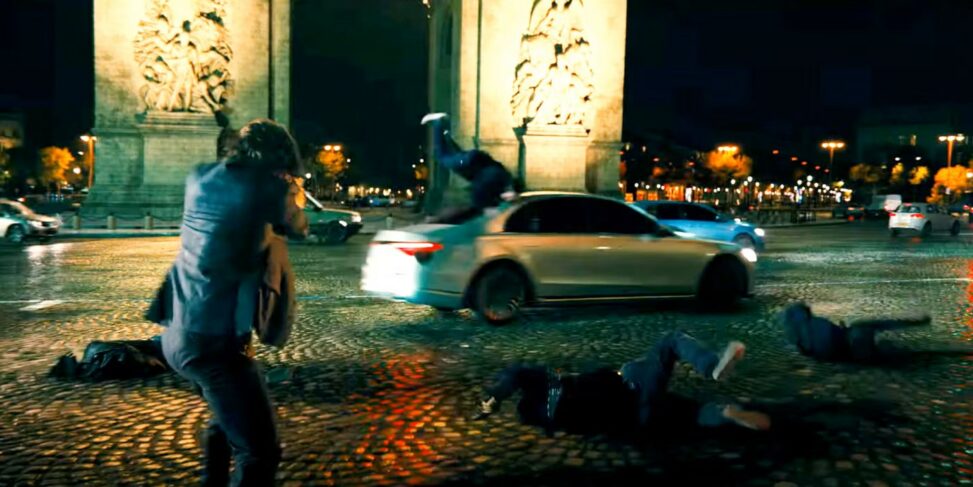The most recent action film I’ve watched is John Wick: Chapter 4 (2023), which was directed by Chad Stahelski. One of the most chaotic scenes occurs at Paris’ Arc de Triomphe, where John is embroiled in a deadly shootout while automobiles speed by at high speed. It’s a disaster, but it’s also one of the best-executed action scenes I’ve witnessed in a very long time.
Description and Analysis of the Action Moment
The image I chose shows John Wick right in the center of a high-speed shootout at the Arc de Triomphe. He’s got moving traffic around him, he’s got adversaries firing, and he’s shooting back. Besides, the people behind this visually stunning event deserve a mention that city lights reflect off the wet pavement, bullets flash in the dark, and cars crash around him like it’s part of a choreographed dance.
This moment is a very good example of mise en scène. The lighting, the clothes that the characters are wearing, and the place of the action all support the film’s mood—stylized, dark, and intense. The cuts are numerous, but they are not hard to follow. In just one minute, there are at least 50 cuts, but it is still fluid. The camera pans up/down and is swung around but rather than do nothing, it goes from following John to showing everything in chaos and then zooming in for the audience to feel the hit. You’re always moving with the action, and even though you notice the edits, they add to the rhythm rather than take you out of it.
John’s character is also a strong clue. John is a man who is represented to be white, able-bodied and very close to be a superhero. He does not stop fighting despite being always injured. The people who fight him are often masked or foreign, thus, confirming some of the most widespread action movie clichés. The scene takes a very real place such as Paris and transforms it into a capture area for the underworld, thus making the environment part of the action. Cars become weapons and the road the battlefield.
How This Fits in With the Genre
This scene reminds of the recent master tendency in action movies. The trend is to make violence, a phenomena people see as horrible, quite a trifle. Redmon (2019) argues, that the John Wick movie presents the audience with visuals and feelings, not just an event—the story are fights, and they are like choreographed songs. each shot is a picture or a piece of art, even if it shows violent material.
Most action films hide their bad execution under shaky shots and distorted image tricks. The latest instalment breaks the mould and uses other methods that make the product look stylish and more eye-catching, hence shaking off the stereotypes about deadly action films (Parker, 2016). The directors don’t hesitate to showcase their creation and expose just how skillful their work is. It’s not a trait all movie franchises can boast of; the confidence of taking things slower so that the audience has time to admire the minutiae of a fight is remarkable.
Keanu Reeves also introduces a new aspect of the role. His character is somber, focused, and gripping, whereas, in contrast, the character isn’t like that at all. The readers can easily understand Feasey (2022) that argues Reeves is more inclined to create real personalities than men using brute force, valid here. He doesn’t utter much, but you still understand the feelings who he is.
Moreover, Thomas (2022) maintains the opinion that the actor is being real himself has a direct influence on the public’s perception of Wick. The actor’s positive image of personal life is what is expected to be portrayed in his character, the kind that is forgiving of sins in the masses’ minds. That is also an instance of the intersection between the personality of the actor and his film role in a successful film franchise.
From a media representation perspective, it’s intriguing to see how this movie might shape conceptions of power and masculinity. Critical Disability Media Studies (Oxford University Press, 2023) highlights a common stereotype in, especially, action movies that heroes are presented as outright unbeatable. This side of their characterization is illustrative of the larger, more significant issue of disability representation in media, and it’s obvious that for an able-bodied hero, John is constantly presented as unbeatable.
Box Office Performance
John Wick: Chapter 4 turned out to be a great win at the box office, making revenue over $432 million worldwide (Box Office Mojo, 2023). It’s the biggest billing film of the series, proving that the public is still very much in favor of such high-concept action movies.
Real-Life Consequences for Viewers
It is often up for debate whether films of this kind really influence viewers in real life. The violence in John Wick is no doubt over the top and stylized, but that doesn’t necessarily mean it is without an effect. Redmon (2019) puts forth the idea that when the violence is presented in such a clean and beautiful manner, it may result in the desensitization of some, as it no longer seems real but becomes mere entertainment.
On the other hand, the film, in part, does communicate the reasons behind its violence—John is not just a killing loving character. There is a personal, emotional story behind the whole thing. However, most viewers may not fully catch the message. The point is that especially younger audiences might pick up only on “cool” violence, which is something for reflection.
References
Feasey, R. (2022). From The One to John Wick: Keanu Reeves and the action genre. In S. Gerrard & R. Middlemost (Eds.), Gender and Action Films 1980–2000 (pp. 199–212). Emerald Publishing. https://doi.org/10.1108/978-1-80117-506-720221013
Oxford University Press. (2023). Critical disability media studies. https://academic.oup.com/edited-volume/58202/chapter/482138846
Redmon, D. (2019). Aestheticized violence and the neo-action hero in the John Wick franchise. Film Criticism, 43(3). https://doi.org/10.3998/fc.13761232.0043.308
Thomas, S. (2022). Keanu Reeves, John Wick, and the myths and tensions between star brands and franchise properties. Celebrity Studies, 13(2), 244–258. https://doi.org/10.1080/19392397.2022.2063405


Ajay Ajay
This analysis of John Wick: Chapter 4 is good to describe the action sequence and how the scene uses mise en scene, character representation, and camera modes to build up the tension of the shootout. The description of the action at the Arc de Triomphe is very clear with a clear focus on the physicality of the setting—how the moving cars and slippery road contribute to the visual chaos. The discussion of the camera movements is especially helpful, determining how the cuts enhance the movement instead of breaking it off. The mention of the 50 cuts per minute highlights the frenzied speed of the action without compromising on understanding. The criticism does, however, seem to me to need to explore a bit more how the action sequence is symptomatic of broader trends in the action genre. The critique refers to the choreography and visuals briefly, but there is room to explore how John Wick: Chapter 4 fits into the evolution of action films, especially in the depiction of violence and its impact on the audience. The references to Redmon (2019) and Parker (2016) are appropriate but can be more integrated, particularly in explaining how the violence aesthetics of the scene reinforce or undermine typical Hollywood action tropes. The presentation of John Wick as a hyper-able, invincible hero must also be further explored, particularly regarding disability representation in media. Although the Oxford University Press (2023) source is useful, it is somewhat underdeveloped in analysis terms. There are some references to how violence impacts real life briefly, but I would have liked more detailed analysis of how this fantastical violence impacts audience behavior or comprehension, especially among younger audiences. So basically, the analysis is well-structured and makes astute observations, but there is scope for more nuanced discussion, particularly in connecting the scene to larger genre trends and drawing more advanced comments about media representation’s impact.